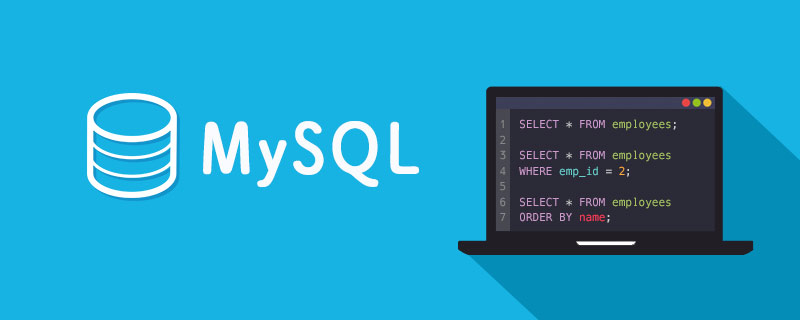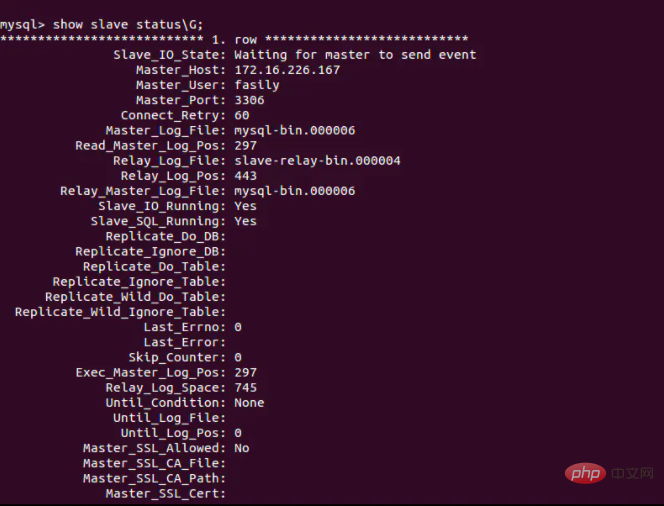service mysql start
mysql master-slave replication
mysql video tutorial Column introduces master-slave replication

##Related free learning recommendations:Database replication plays a very important role in improving system high availability and high performance. This article summarizes the relevant knowledge involved in mysql master-slave replication. If you happen to be working in this area, I hope you can learn more about it. You helped. 1 Main library configuration1.1 my.cnf configuration: Configure the following basic configuration in the main library configuration file my.cnf:
log-bin = mysql-bin //二进制日志文件名称主体 log-bin-index = mysql-bin.index //二进制日志文件索引文件 server-id = 1 //唯一的服务器ID,为了保持唯一性,可以去ip的尾部 binlog-format = mixed //控制复制基于的方式,有基于语句(statement),基于行(row),混合(mixed),**主从库需要保持一致** #sync_binlog=1 //推荐配置,开启该选项,mysql每次在事务提交前会将二进制日志同步到磁盘上,保证在服务器崩溃时不会丢失事件。
比如说要指定db1和db2两个数据库进行主从复制: binlog-do-db = db1 binlog-do-db = db2
mysql> grant replication slave, replicatin client on \*.\* to repl@'172.16.226.192' identified by 'repl123456'; //其中repl是用户名,repl123456为账户密码,172.16.226.168为备库的地址。 mysql> flush privileges; //在不重启mysql服务的情况下完成权限的更新
relay-log = slave-relay-bin //中继日志文件名称主体 relay-log-index = slave-relay-bin.index //中继日志文件索引文件 server-id = 2 //唯一的服务器ID,必须要异于主库 #read_only = 1 //限制备库为只读,可选 log_slave_updates = 1 //控制是否在中继日志执行之后,将同步过来的数据添加到自己的binlog中去,1代表是 skip_slave_start // 该选项能够阻止备库在崩溃后自动启动复制,建议开启 即使开启了建议的选项,备库仍然可能在崩溃后被中断,因为master.info和中级日志文件都不是崩溃安全的,所以建议开启一下选项: sync_master_info = 1 sync_relay_log = 1 sync_relay_log_info = 1
mysql> grant reload, lock tables, replication client on \*.\* to backup@'%' identified by 'backup123'; mysql> flush privileges; //在不重启mysql服务的情况下完成权限的更新
innobackupex-1.5.1 --defaults-file=/etc/mysql/my.cnf --user=backup --password=backup123 /mysqlbackup --defaults-file:选择默认的配置文件 --user和--password:分别为进行备份的用户名和密码 /mysqlbackup:目标目录
The --apply-log option of the innobakupex command can be used to implement the above functions. For example, the following command:
innobackupex-1.5.1 --apply-log --user=backup --password=backup123 /mysqlbackup/2017-01-11_21-20-57 如果执行正确,其最后输出的几行信息通常如下: xtrabackup: starting shutdown with innodb_fast_shutdown = 1 120407 9:01:36 InnoDB: Starting shutdown... 120407 9:01:40 InnoDB: Shutdown completed; log sequence number 92036620 120407 09:01:40 innobackupex: completed OK!
scp -r /mysqlbackup/ copyer@192.168.1.192:/data/
Before data recovery, first close the slave server mysql service and obtain it from the xtrabackup_binlog_info file in the backup folder The binary log file currently in use, and the location where the binary log events up to this point are backed up. If the datadir directory is not empty, you also need to clear the datadir directory. The --copy-back option of the innobackupex command is used to perform a recovery operation. It performs the recovery process by copying all data-related files to the datadir directory of the mysql server. innobackupex obtains relevant information about the datadir directory through backup-my.cnf (you can also specify the my.cnf directory through --defaults-file, and make sure the datadir path is empty)
innobackupex-1.5.1 --copy-back /mysqlbackup 如果执行正确,其输出信息的最后几行通常如下: innobackupex: Starting to copy InnoDB log files innobackupex: in '/backup/2012-04-07_08-17-03' innobackupex: back to original InnoDB log directory '/mydata/data' innobackupex: Finished copying back files. 120407 09:36:10 innobackupex: completed OK!
chown -R mysql:mysql /var/lib/mysql/
service mysql start
Copy after login
If opening mysql fails, you can find the reason for the failure by checking the error log. 4.2 Establish a master-slave connectionThe slave library connects to the master library through the replication account: (slave must be in stop state for the following connection to take effect)
service mysql start
mysql> change master to master_host='192.168.1.208',master_user='repl', master_password='repl123456',master_log_file='mysql-bin.000001'(备份时得到的活动日志),master_log_pos=0(备份时得到的活动日志中事件的位置);
Note : If the master cannot be connected here during the master-slave connection, one possible reason is that the local machine is bound in the my.cnf configuration file, that is, bind-address = 127.0.0.1. What we need to do Just comment it out, otherwise external machines will not be able to access it.
Open slave:mysql> start slave;
mysql> show slave status; Slave_IO_Running: Yes //表示IO线程运行正常 Slave_SQL_Running: Yes //表示SQL线程运行正常 Seconds_Behind_Master: 0 //表示在网络条件较好的情况下,从库能够及时同步上主库
mysql> show processlist\G; //查看数据库服务线程情况
mysql> show master/slave status\G; //查看主备库状态
mysql> flush logs; //强制轮换(rotate)二进制日志,从而得到一个完整的二进制日志文件
mysql> show binlog events in '指定二进制日志文件名称' from (从指定位置开始显示) limit (需要显示的事件数量)\G; //查看binlog中事件
mysql> show binary logs; //显示所有的binlogs
mysql> reset master; //删除所有二进制日志文件并清空索引文件
mysql> reset slave; //删除slave上复制用的所有文件重新开始
mysql> show slave hosts; //查看主库所拥有的从库信息
Copy after login
mysql> show processlist\G; //查看数据库服务线程情况 mysql> show master/slave status\G; //查看主备库状态 mysql> flush logs; //强制轮换(rotate)二进制日志,从而得到一个完整的二进制日志文件 mysql> show binlog events in '指定二进制日志文件名称' from (从指定位置开始显示) limit (需要显示的事件数量)\G; //查看binlog中事件 mysql> show binary logs; //显示所有的binlogs mysql> reset master; //删除所有二进制日志文件并清空索引文件 mysql> reset slave; //删除slave上复制用的所有文件重新开始 mysql> show slave hosts; //查看主库所拥有的从库信息

0:每隔一秒,把事务日志缓存区的数据写到日志文件中,以及把日志文件的数据刷新到磁盘上; 1:每个事务提交时候,把事务日志从缓存区写到日志文件中,并且刷新日志文件的数据到磁盘上; 2:每事务提交的时候,把事务日志数据从缓存区写到日志文件中;每隔一秒,刷新一次日志文件,但不一定刷新到磁盘上,而是取决于操作系统的调度;
取1时的IO耗费最大,虽然一致性和完整性方面效果最好,但是写入效率最低,而这也是导致从库延迟较大的原因(如果服务器配置较高或许会好些)。取0时mysql写入性能很好,但如果 mysqld 进程崩溃,通常会导致最后 1s 的日志丢失 。取2时的写入性能也很好,每次事务提交会写入日志文件,但并不会立即刷写到磁盘,日志文件会每秒刷写一次到磁盘。这时如果 mysqld 进程崩溃,由于日志已经写入到系统缓存,所以并不会丢失数据;在操作系统崩溃的情况下,通常会导致最后 1s 的日志丢失。
6 混合模式复制
正常情况下使用使用基于语句的复制,而对不安全的语句则切换到基于行的复制。主要有以下几种情况:
- 该语句调用了:
- UUID函数
- 用户自定义函数
- CURRENT_USER或USER函数
- LOAD_FILE函数
- 一个语句同时更新了两个或者两个以上含有AUTO_INCREMENT列的表
- 语句使用了服务器变量
- 存储引擎不允许使用基于语句的复制,例如,mysql cluster引擎
7 复制过滤
有时候我们不需要对数据库中所有的库进行复制,或者不想对指定库中的某些表进行复制操作,那么我们就需要对复制进行一定的过滤配置,以达到更合理的复制效果。
1. 基于master
**binlog-do-db=mysql**:主库只是将指定库(mysql)发生的变化记录到二进制日志中。 **binlog-ignore-db=mysql**:主库取消将指定库(mysql)发生的变化记录到二进制日志中。
2. 基于slave
针对数据库进行的过滤:
**replicate-do-db=mysql**:从库只是将指定库(mysql)发生的变化进行重现。 **replicate-ignore-db=mysql**:从库取消将指定库(mysql)发生的变化进行重现。 针对表进行的过滤: **replicate-wild_do-table=mysql.learn**:从库只是将指定库(mysql)中指定表(learn)发生的变化进行重现。 **replicate-wild_ignore-table=mysql.learn**:从库取消将指定库(mysql)中指定表(learn)发生的变化进行重现。
以上复制过滤方式乍一看没有问题,其实还是有需要注意的地方。因为这些过滤方式的效果与复制方式有关系。如果是基于语句的复制,binlog-do-db、binlog-ignore-db、replicate-do-db、replicate-ignore-db与跨库(如use库内和use外)有关系,这一点需要注意。
8 日志清理
暴力清理:(没有主从复制的情况下)
1、重启mysql服务器即可关闭bin日志的记录 2、通过reset master命令进行清理
条件清理
如果存在主从复制关系,则应当使用purge的方式来清理bin日志,语法如下:
purge {master|binary} logs to 'log_name'
purge {master|binary} logs before 'date'用户删除列于在指定的日志或日期之前的日志索引中的所有二进制日志,同时这些日志也会从日志索引文件的清单中删除。
eg. purge master logs to 'mysql-bin.000005'; purge master logs before '2014-08-30 00:00:00';//清除指定日期之前的日志 purge master logs before date_sub(now(),Interval 3 day);清除三天前的日志
定时清理
参数:expire_logs_days
说明:二进制日志自动删除/过期的天数。默认值为'0',即没有过期的
示例:expire_logs_days = 5,代表日志的有效时间为5天
什么时候会删除过期日志?
每次进行log flush的时候会自动删除过期的日志
什么时候会触发log flush?
1、重启 2、binlog文件的大小达到了最大限制 3、手动执行flush logs命令
写在最后
本文只是结合自己的学习以及实践过程进行了相关总结,如有不妥之处望您批评指正。推荐大家学习《高可用MYSQL》、《高性能MYSQL》两本书,最重要的还是实践实践再实践,欢迎交流,共同进步。
想了解更多编程学习,敬请关注php培训栏目!
The above is the detailed content of mysql master-slave replication. For more information, please follow other related articles on the PHP Chinese website!

Hot AI Tools

Undresser.AI Undress
AI-powered app for creating realistic nude photos

AI Clothes Remover
Online AI tool for removing clothes from photos.

Undress AI Tool
Undress images for free

Clothoff.io
AI clothes remover

AI Hentai Generator
Generate AI Hentai for free.

Hot Article

Hot Tools

Notepad++7.3.1
Easy-to-use and free code editor

SublimeText3 Chinese version
Chinese version, very easy to use

Zend Studio 13.0.1
Powerful PHP integrated development environment

Dreamweaver CS6
Visual web development tools

SublimeText3 Mac version
God-level code editing software (SublimeText3)

Hot Topics
 PHP's big data structure processing skills
May 08, 2024 am 10:24 AM
PHP's big data structure processing skills
May 08, 2024 am 10:24 AM
Big data structure processing skills: Chunking: Break down the data set and process it in chunks to reduce memory consumption. Generator: Generate data items one by one without loading the entire data set, suitable for unlimited data sets. Streaming: Read files or query results line by line, suitable for large files or remote data. External storage: For very large data sets, store the data in a database or NoSQL.
 How to use MySQL backup and restore in PHP?
Jun 03, 2024 pm 12:19 PM
How to use MySQL backup and restore in PHP?
Jun 03, 2024 pm 12:19 PM
Backing up and restoring a MySQL database in PHP can be achieved by following these steps: Back up the database: Use the mysqldump command to dump the database into a SQL file. Restore database: Use the mysql command to restore the database from SQL files.
 How to optimize MySQL query performance in PHP?
Jun 03, 2024 pm 08:11 PM
How to optimize MySQL query performance in PHP?
Jun 03, 2024 pm 08:11 PM
MySQL query performance can be optimized by building indexes that reduce lookup time from linear complexity to logarithmic complexity. Use PreparedStatements to prevent SQL injection and improve query performance. Limit query results and reduce the amount of data processed by the server. Optimize join queries, including using appropriate join types, creating indexes, and considering using subqueries. Analyze queries to identify bottlenecks; use caching to reduce database load; optimize PHP code to minimize overhead.
 How to insert data into a MySQL table using PHP?
Jun 02, 2024 pm 02:26 PM
How to insert data into a MySQL table using PHP?
Jun 02, 2024 pm 02:26 PM
How to insert data into MySQL table? Connect to the database: Use mysqli to establish a connection to the database. Prepare the SQL query: Write an INSERT statement to specify the columns and values to be inserted. Execute query: Use the query() method to execute the insertion query. If successful, a confirmation message will be output.
 How to create a MySQL table using PHP?
Jun 04, 2024 pm 01:57 PM
How to create a MySQL table using PHP?
Jun 04, 2024 pm 01:57 PM
Creating a MySQL table using PHP requires the following steps: Connect to the database. Create the database if it does not exist. Select a database. Create table. Execute the query. Close the connection.
 How to use MySQL stored procedures in PHP?
Jun 02, 2024 pm 02:13 PM
How to use MySQL stored procedures in PHP?
Jun 02, 2024 pm 02:13 PM
To use MySQL stored procedures in PHP: Use PDO or the MySQLi extension to connect to a MySQL database. Prepare the statement to call the stored procedure. Execute the stored procedure. Process the result set (if the stored procedure returns results). Close the database connection.
 How to fix mysql_native_password not loaded errors on MySQL 8.4
Dec 09, 2024 am 11:42 AM
How to fix mysql_native_password not loaded errors on MySQL 8.4
Dec 09, 2024 am 11:42 AM
One of the major changes introduced in MySQL 8.4 (the latest LTS release as of 2024) is that the "MySQL Native Password" plugin is no longer enabled by default. Further, MySQL 9.0 removes this plugin completely. This change affects PHP and other app
 The difference between oracle database and mysql
May 10, 2024 am 01:54 AM
The difference between oracle database and mysql
May 10, 2024 am 01:54 AM
Oracle database and MySQL are both databases based on the relational model, but Oracle is superior in terms of compatibility, scalability, data types and security; while MySQL focuses on speed and flexibility and is more suitable for small to medium-sized data sets. . ① Oracle provides a wide range of data types, ② provides advanced security features, ③ is suitable for enterprise-level applications; ① MySQL supports NoSQL data types, ② has fewer security measures, and ③ is suitable for small to medium-sized applications.






